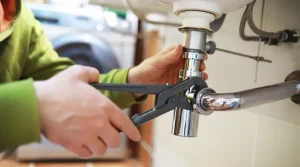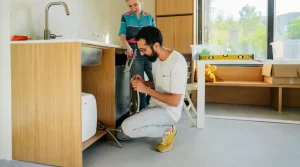A manual drain snake can be your best option if the clog is too difficult to remove with a plunger but you aren’t ready to give up just yet. A tool that “snakes” down into pipes to clear obstructions is a plumber’s snake or drain auger. Snaking a pipe is a middle-ground solution between plunging and using powerful drain augers or other professional equipment.
Compared to plungers, plumber snakes are a more effective DIY drain cleaner, but they are also trickier to use. They might be challenging to control in tight curves and twists. Learn how your snake functions and how to use it properly to prevent costly mistakes. Here is all the information you need to know about using a drain snake.
What is an auger, exactly, and how do you use one?
Simply put, an auger is a tool used to bore through objects. An auger can be a drill. A long, flexible metal cable called a plumbing auger or snake has a handle on one end and a small, uncoiling spring on the other. The snake’s auger head resembles a corkscrew. A typical home plumbing auger is 20 to 50 feet long. When not in use, the cable coils into a cylinder-shaped casing. Most hand-operated home plumber’s snakes have a rotating handle or crank to release and move the cable. You may navigate through challenging locations by rotating the coil while turning the handle.
Entering the drain directly to physically contact and subsequently remove the obstruction causing the clog is known as “snaking.” Before manually feeding the snake till it reaches the obstruction, you first insert the auger head into the drain. The snake continues to advance through the drainpipe as it uncoils until the head pierces the barrier. Here is a more thorough explanation of how to operate a drain auger:
How To Use A Drain Snake:
- Place some old towels underneath the pipes you’re working on and put on some clothes you don’t mind getting muddy. Your snaking operation may get messy depending on the type of clog. This is crucial if you decide to remove the p-trap.
- (Optional but recommended) (Optional but recommended) Think about taking out the p-trap. The wavy section of piping under the sink is the p-trap. It joins the sink to your home’s larger drainage system. Sewer gasses won’t be able to rise through the sink and into the house because of the way it is curved. P-traps can also be formed of metal, however, PVC pipe is the most common material used.
The p-trap can be manually removed using either your hands or an adjustable wrench. After removing the p-trap, you should give it a thorough inspection and cleaning. If you’ve identified your obstruction, you might not even need to snake! Snaking is frequently made simpler by removing the trap since it avoids this challenging twist.
- You could think about taking the trap arm off. The section of pipe between the p-trap and the wall pipe is known as a trap arm. It secures the p-trap and may curve once more to reach the wall. Search for the nut holding the trap arm to the wall in plastic or metal. If you can, loosen it so you can take out the trap arm. If you can’t, the arm might be bonded in place; in that case, you shouldn’t try to take it off. Once the trap arm has been removed, make sure to wipe it out similarly to how you handled the p-trap.
You get the best access to the drainpipe by removing the trap arm. Check the drainpipe for any clogs inside. Try to get rid of the obstruction if you can see it from where you are. Use your snake if you are unable to.
- Manually insert the snake’s auger head into the pipe. If you didn’t remove the trap, insert the snake’s head into the drain; otherwise, insert it through the wall access hole. If you didn’t get the trap out, you might want to snake when cold water is running.
Avoid using excessive force when inserting the auger into the drain to avoid damaging the pipe or drain entry. To successfully snake a drain, take your time and make sure the head and cable aren’t too broad for it.
- Start using the snake to uncoil the snake. Keep the snake’s handle as near as you can to the pipe’s opening. The more force you apply to the pipe, the less slack the auger has.
Feed the line slowly and steadily. The blockage or merely a bend in the pipe may have been encountered if you ever feel resistance as the cable travels through the pipe.
- Push on through the obstacle while rotating the handle to move the head back and forth. Avoid jamming the auger into the pipe’s walls and instead try to get around the obstruction or around the corner. You should stop snaking and adjust if you hear scraping sounds. Turning the crank steadily while pushing and pulling can be beneficial.
- Remove the snake and put the sink’s parts back together. Look for any leftover impediment in the auger head and remove it. At this stage, you should reinstall the trap arm and p-trap if you previously removed them.
- Examine the sink. The snake should have been able to remove the obstacle and clear the clog. You could try repeating the snaking operation if you still have a clog. However, using a drain snake excessively might ruin your pipes or drains, just as repeatedly plunging. It could be time to bring in the experts if a thorough snaking didn’t resolve your issue.
Clifton expert drain cleaning
Snaking is a surprisingly simple and affordable DIY project for homeowners. You should be able to unclog annoying clogs from your sink, bathtub, or toilet as long as you know how to use your snake and have the patience to manage it.
For those occasions when no matter what you do, you just can’t get past that clog. Don’t give up! The next step is to call BJC Clifton Plumbers after your snake. We have the equipment and expertise to locate and remove any obstruction outside of the Clifton traffic.




